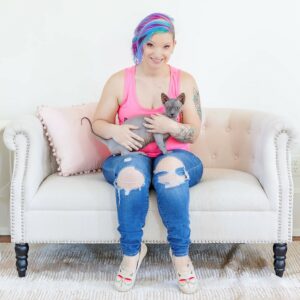Barks Blog
Meet Laura Cassiday of Pawsitive Vibes Cat Behavior and Training

Laura Cassiday takes cat owners from hopeless to hopeful using her feline expertise and force-free training techniques.
Tell us a little bit about yourself. How did you first get into animal behavior and training, and what you are doing now?
I studied English and professional writing in college and grad school, and worked a couple of writing and editing jobs. In 2017, I was so bored and miserable that I just quit without any real plans. I took some time to figure out what I wanted to do with my life, and ended up getting a job at the Maryland SPCA doing shelter intake. One thing led to another, and I moved to the kennel and finally the behavior department. I had always been cat savvy, but this is where I had the opportunity to really learn about R+ training and get a ton of hands-on experience with cats and dogs with behavior problems. In early 2021, I opened Pawsitive Vibes Cat Behavior and Training as a side business, and by the end of the year, I was so busy that ultimately I ended up leaving the shelter and doing private behavior consulting full time.
Tell us a little bit about your own pets.
Oh, man. So, I have eight cats right now. Dragon is 6 and probably the smartest cat ever. He loves to learn new things, and the worst thing I ever did was teach him the “touch” cue because now when he wants attention, he will just start TOUCHING things. Sunny is 18 and basically surgically attached to me. If you are ever on a Zoom call with me, you’ve seen him. He is orange and toothless. Ripley is 2 and a bambino, which is a cross between a munchkin and a sphynx. All my other animals are hot messes, so I felt like I deserved one fancy designer breed. I don’t recommend them for beginners, because they’re super high maintenance and need extra vet care at baseline. Juniper is 7 and one of my two tripods. She’s a long-haired gray cat, and we call her a “supermeowdel.” She knows she’s gorgeous. Bean is 2 and my other tripod, and now we’re getting into the brown tabby gang. She is pretty shy and reserved, but my (secret) favorite child. She also has half of a tail—she suffered some kind of major trauma as a tiny kitten, before she was 5 weeks old when I got her. Kiki is 2, also a brown tabby, and has hydrocephalus. She wasn’t expected to live past 1 year, but she’s already more than doubled her life expectancy. She’s a special girl who requires a lot of work because she isn’t mentally or physically capable of using a litter box, is blind and takes medication for seizures. Lennox is 1, a brown tabby and my semi-feral boy. I got him as a feral 12-week-old kitten. I was hoping to socialize him and adopt him out, but he only socialized to me, and I ended up keeping him so he wouldn’t end up in a barn. He has made so much progress and loves to snuggle with me and occasionally my husband, but anyone else is a no-go. Puff is 1, a brown tabby and blind. He is my troublemaker and loves to play. He is a very persistent feet biter if he doesn’t get his regular scheduled play time.
What do you consider your area of expertise?
I love working with aggression cases in cats, particularly play aggression and food aggression.
Why did you become an animal behavior and training professional?
I was bored with my job at the time and wanted to do something I cared about. I love cats, and I never get bored of them. I loved making a difference in shelter work, and now I love working for myself as a private behavior consultant!
What species do you work with?
Cats. I will dabble in dogs and horses, but cats are my strong point.
Are you a crossover trainer or have you always been a force-free trainer?
I learned force-free methods from the beginning. However, I was definitely a cat owner who used squirt bottles and SSScat [motion-activated air spray deterrent] before I learned better.
What drives you to be a force-free professional, and why is it important to you?
The first time I ever tried clicker training was with my cat, Dragon. I had no idea what I was doing and saw a tutorial on the internet for how to teach your cat a high-five. Once we got into it, I saw a side of Dragon I had never seen before. He was so eager and so excited, and it felt like we were two different species speaking the same language. He started to run to where I kept the clicker and beg for training. That was the moment I knew that force-free training was the answer.
Who has most influenced your career and how?
It’s so many people. I can’t name just one. I would have to say it’s my cats, too—Dragon, for showing me how R+ training can build a relationship with your cat and help you bond, and Lennox for proving that using force-free socialization methods and cooperative care with fearful/feral cats can yield substantial results.
How has the PPG helped you to become a more complete trainer?
PPG has so many free resources just for being a member. They really foster a community, and everyone is so welcoming and supportive. I know I can always go to any PPG member with a question or if I need anything.
What are some of your favorite force-free techniques for commonly encountered client-pet problems?
Stationing/mat training is one of my favorites. You can use it for anything—fear, aggression, counter surfing, food stealing, helping cats learn to accept nail trims or medication … it’s like a one-size-fits-all skill.
What is the reward you get out of a day’s work with people and their pets?
The results. Keeping cats in homes. Helping people mend their relationship with their cats. Taking people from hopeless to hopeful.
What is your favorite part of your job?
Petting cats—which surprisingly isn’t something that I get to do very often.
What is the funniest or craziest situation you have been in with a pet and their owner?
One time a cat owner said they were hesitant to give their cat a larger litter box because they didn’t want the cat to grow any bigger. They thought that because apparently goldfish don’t grow larger than the size of the bowl they’re kept in, they wanted the same thing for their cat. You can’t make this stuff up.
What special work-related projects or activities are you currently involved in?
Lots of stuff with PPG. Presenting at PPG’s Arizona summit, serving as the PPG Feline Division chair. It keeps me busy!
How have these special projects or activities helped your business, career or service offerings?
Networking. Getting more involved in PPG has allowed me to meet and become friends with so many awesome cat people. No one told me when I started my own business that networking would be so important, but it really is. It can also be pretty lonely working for yourself, especially when you’re the only person within driving distance who does cat behavior, so getting to meet and talk to other cat behavior professionals has kept me sane.
What’s next for you?
I’m hoping to expand my business this year with new service offerings and more resources for cat owners. I want to speak more and do more education for rescues and shelters. I am hoping to be able to take on a few aspiring cat behavior consultants as mentees this year, as well.
What advice would you give to a new animal behavior and training professional starting out?
Just go for it. You’ll never feel ready or qualified or prepared. But the best way to learn is through doing. The best trainers know they don’t know everything and are willing to learn.
Laura Cassiday is the owner of Pawsitive Vibes Cat Behavior and Training in Baltimore, Maryland.
She is also the chair of PPG’s Feline Division and a member of PPG’s Steering Committee.

